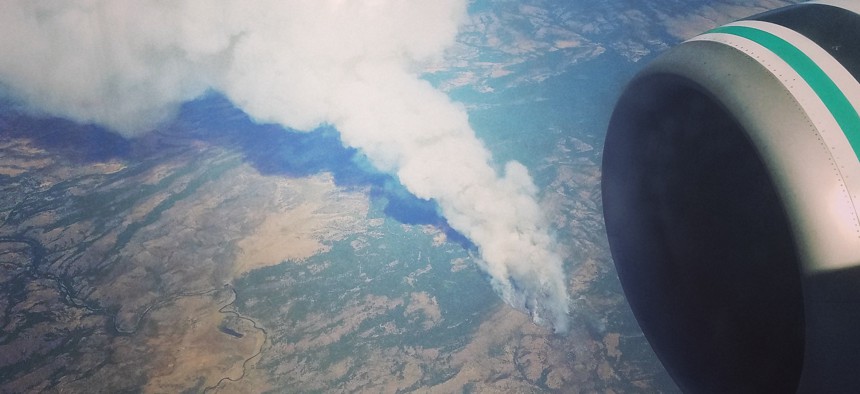A Bird’s-Eye View of a Bad Wildfire Season in the West

Flying above the remnants of the Long Valley Fire near the California-Nevada border on Friday. Michael Grass / Route Fifty
So far this year, fires have burned 5.2 million acres of land. And it’s only going to get worse.
Flying from Los Angeles to Seattle on Friday afternoon, it was abundantly clear that the 2017 wildfire season in Western states is fully underway: It was easy to spot blazes on the trip north, including a fire in the vicinity of the California-Nevada border north of Reno.
Although the Long Valley Fire , which started July 11 near Doyle, California, was 100 percent contained after 10 days, that doesn’t mean the blaze is completely out. A large plume of smoke continued to emanate from the impacted area near Pyramid Lake. In all, the Long Valley Fire consumed nearly 84,000 acres of grass and sagebrush, according to the National Wildfire Coordinating Group’s incident report.
As Climate Central reported, since the beginning of the year, there have been 37,000 fires that have burned through 5.2 million acres of land. As of Friday, there were 47 major fires in nine states.
That included the Detwiler Fire near Yosemite National Park in California, which has burned nearly 82,000 acres and destroyed 63 residences, 67 minor structures, and one commercial structure, according to a CalFire incident report. As of Sunday, that blaze was 85 percent contained.
Montana has been hard hit by this year’s fire season, which will have immediate and long-term impacts for ranchers, who are now facing hay shortages and charred landscapes unsuitable for grazing.
As the Billings Gazette reported Sunday :
The Lodgepole Complex fires didn't just wipe out this year, they wiped out years to come. Many ranchers will likely have to sell off cattle to survive—losing years of carefully honed genetics. Other ranchers will have to wait until 2019 to see new calves reach market age—and who knows how they'll make it until then. And for new, young ranchers, the fires may have wiped out their budding businesses before they even got on their feet.
Over the next few days, a hot dry air mass in the Southwest will push north into the Pacific Northwest and western Canada—on Thursday, high temperatures in normally temperate Seattle could hit 100 degrees.
Federal, state and local firefighting agencies across the West remain on high alert.
But there’s a new firefighting tool available. Last week, the U.S. Forest Service gave a 17-month interim approval for a 747 Supertanker aircraft operated by Global SuperTanker, according to FireAviation.com .
Watch the aircraft in action in Chile:
Michael Grass is Executive Editor of Government Executive's Route Fifty and is based in Seattle.
NEXT STORY: Trump's Vision of Lawless Order






